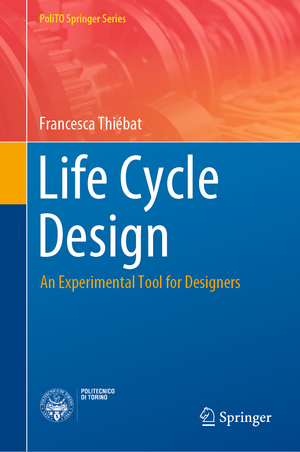Life Cycle Design: An Experimental Tool for Designers: PoliTO Springer Series
Autor Francesca Thiebaten Limba Engleză Hardback – 5 mar 2019
Din seria PoliTO Springer Series
- 15%
 Preț: 638.43 lei
Preț: 638.43 lei - 20%
 Preț: 646.80 lei
Preț: 646.80 lei - 20%
 Preț: 552.18 lei
Preț: 552.18 lei - 20%
 Preț: 545.73 lei
Preț: 545.73 lei - 18%
 Preț: 1119.38 lei
Preț: 1119.38 lei - 23%
 Preț: 607.33 lei
Preț: 607.33 lei - 24%
 Preț: 573.63 lei
Preț: 573.63 lei - 20%
 Preț: 594.74 lei
Preț: 594.74 lei - 18%
 Preț: 785.42 lei
Preț: 785.42 lei - 20%
 Preț: 552.07 lei
Preț: 552.07 lei - 18%
 Preț: 1220.12 lei
Preț: 1220.12 lei - 18%
 Preț: 1001.65 lei
Preț: 1001.65 lei - 18%
 Preț: 718.15 lei
Preț: 718.15 lei -
 Preț: 436.56 lei
Preț: 436.56 lei -
 Preț: 385.84 lei
Preț: 385.84 lei -
 Preț: 383.12 lei
Preț: 383.12 lei - 15%
 Preț: 638.43 lei
Preț: 638.43 lei - 18%
 Preț: 886.62 lei
Preț: 886.62 lei
Preț: 640.37 lei
Preț vechi: 753.39 lei
-15% Nou
Puncte Express: 961
Preț estimativ în valută:
122.55€ • 133.07$ • 102.94£
122.55€ • 133.07$ • 102.94£
Carte tipărită la comandă
Livrare economică 22 aprilie-06 mai
Preluare comenzi: 021 569.72.76
Specificații
ISBN-13: 9783030114961
ISBN-10: 3030114961
Pagini: 159
Ilustrații: XIII, 157 p. 66 illus., 40 illus. in color.
Dimensiuni: 155 x 235 mm
Greutate: 0.42 kg
Ediția:1st ed. 2019
Editura: Springer International Publishing
Colecția Springer
Seria PoliTO Springer Series
Locul publicării:Cham, Switzerland
ISBN-10: 3030114961
Pagini: 159
Ilustrații: XIII, 157 p. 66 illus., 40 illus. in color.
Dimensiuni: 155 x 235 mm
Greutate: 0.42 kg
Ediția:1st ed. 2019
Editura: Springer International Publishing
Colecția Springer
Seria PoliTO Springer Series
Locul publicării:Cham, Switzerland
Cuprins
Life cycle and sustainability: concepts and keywords.- International models and theories based on the life cycle approach.- Life cycle methodologies.- Definition of an innovative design method based on life cycle approach.- Case studies.- Conclusions and outlooks.
Textul de pe ultima copertă
This book proposes an economic and environmental assessment tool to help private and public building designers and owners determine the global sustainability value of green buildings from a life cycle perspective. As it demonstrates, sustainable life cycle tools for building design and construction can help to achieve successfully integrated architecture. The first part of the book defines the relationship between environmental and economic aspects in a sustainable design approach and illustrates how life cycle methodologies, including Life Cycle Assessment and Life Cycle Costing, can be applied to life cycle design. Further, it highlights methods for calculating costs from LCA data, taking into consideration both discounted cash flow and external costs. In turn, the second part of the book presents an experimental design model, the Life Cycle Design Model (LCDM), which is based on a life cycle design approach that can be used to produce two different outcomes based on two assessment levels. The first assessment level involves creating a grid, called a Design Matrix, which is useful in the design process. The second assessment level involves drawing on LCA and LCC results to develop a user-friendly tool for designers and other actors involved in the building process so that they can assess the most sustainable design option using €CO, a factor that combines the environmental and energy effects of the building system with time and costs. Selected case studies illustrate the practical application of life cycle analysis and show how reflecting the environmental impacts and costs can improve the sustainability of buildings. The LCDM represents a transdisciplinary tool for the design team and, at the same time, allows information on users’ needs and building performance to be communicated between experts and non-experts.
Caracteristici
Offers an authoritative reference work on life cycle assessment and management Includes useful examples that will help readers conduct and pursue their own LCA studies and projects Demonstrates how sustainability in architecture also involves environmental, social and economic aspects
